inflation pressure GMC SIERRA DENALI 2003 Owners Manual
[x] Cancel search | Manufacturer: GMC, Model Year: 2003, Model line: SIERRA DENALI, Model: GMC SIERRA DENALI 2003Pages: 428, PDF Size: 20.35 MB
Page 254 of 428
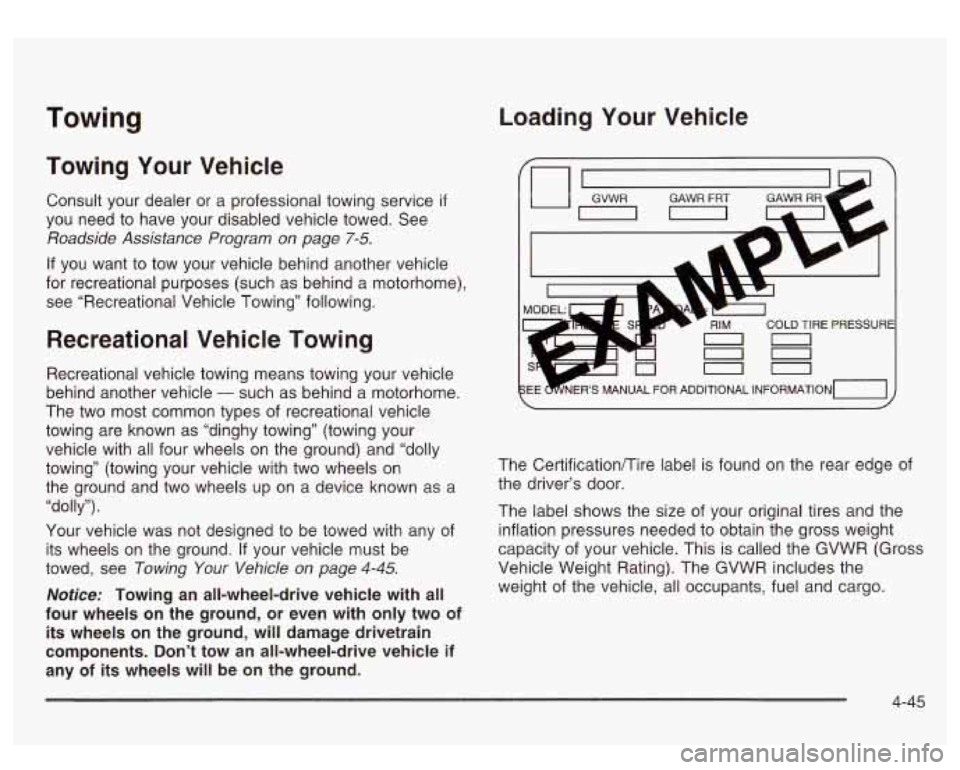
Towing Loading Your Vehicle
Towing Your Vehicle
Consult your dealer or a professional towing service if
you need to have your disabled vehicle towed. See
Roadside Assistance Program on page 7-5.
If you want to tow your vehicle behind another vehicle
for recreational purposes (such as behind a motorhome),
see “Recreational Vehicle Towing” following.
Recreational Vehicle Towing
Recreational vehicle towing means towing your vehicle
behind another vehicle
- such as behind a motorhome.
The two most common types of recreational vehicle
towing are known as “dinghy towing” (towing your
vehicle with all four wheels on the ground) and “dolly
towing” (towing your vehicle with two wheels on
the ground and two wheels up on a device known
as a
“dolly”).
Your vehicle was not designed to be towed with any of
its wheels on the ground. If your vehicle must be
towed, see
Towing Your Vehicle on page 4-45.
Notice: Towing an all-wheel-drive vehicle with all
four wheels on the ground, or even with only two
of
its wheels on the ground, will damage drivetrain
components. Don’t tow an all-wheel-drive vehicle if
any
of its wheels will be on the ground.
COLD TIRE PRESSURE
00
The Certificationflire label is found on the rear edge of
the driver’s door.
The label shows the size of your original tires and the
inflation pressures needed to obtain the gross weight
capacity of your vehicle. This is called the GVWR (Gross
Vehicle Weight Rating). The GVWR includes the
weight of the vehicle, all occupants, fuel and cargo.
4-45
Page 271 of 428
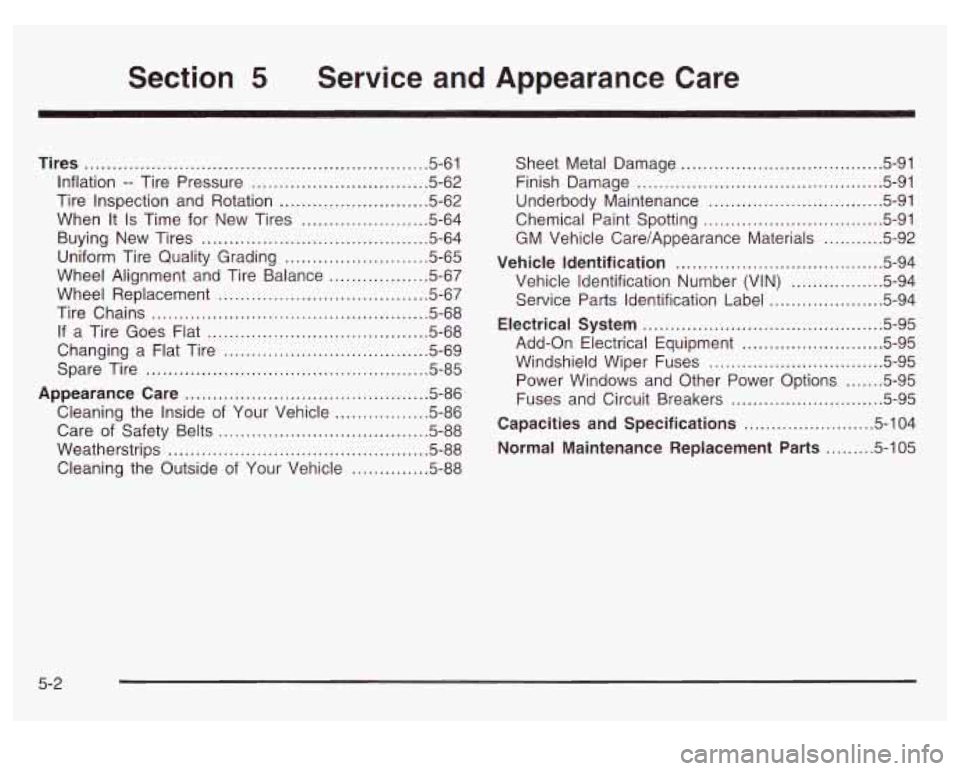
Section 5 Service and Appearance Care
Tires .......................................................... 5-61
Inflation
.. Tire Pressure ................................ 5.62
Tire Inspection and Rotation
........................... 5.62
When It
Is Time for New Tires ....................... 5-64
Buying New Tires
......................................... 5-64
Uniform Tire Quality Grading
.......................... 5-65
Wheel Alignment and Tire Balance
.................. 5.67
Wheel Replacement
...................................... 5.67
Tire Chains
.................................................. 5-68
If a Tire Goes Flat ........................................ 5.68
Spare Tire
................................................... 5.85
Changing a
Flat Tire
.................. ............ 5.69
Appearance Care
............................................ 5.86
Cleaning the Inside of Your Vehicle
................. 5-86
Care of Safety Belts
...................................... 5-88
Weatherstrips
........................................... 5-88
Cleaning the Outside of Your Vehicle
.. .... 5-88
Sheet Metal Damage ..................................... 5-91
Underbody Maintenance
................................ 5-91
Chemical Paint Spotting
............................... -591
Vehicle Identification
...................................... 5-94
Vehicle Identification Number (VIN)
................. 5-94
Service Parts Identification Label
..................... 5-94
Electrical System
............................................ 5-95
Add-on Electrical Equipment
.......................... 5-95
Windshield Wiper Fuses
................................ 5-95
Fuses and Circuit Breakers
............................ 5-95
Capacities and Specifications
........................ 5-104
Normal Maintenance Replacement Parts
......... 5-105
Finish
Damage
............................................. 5-91
GM Vehicle Care/Appearance Materials
........... 5-92
Power Windows and Other Power Options
....... 5-95
5-2
Page 331 of 428
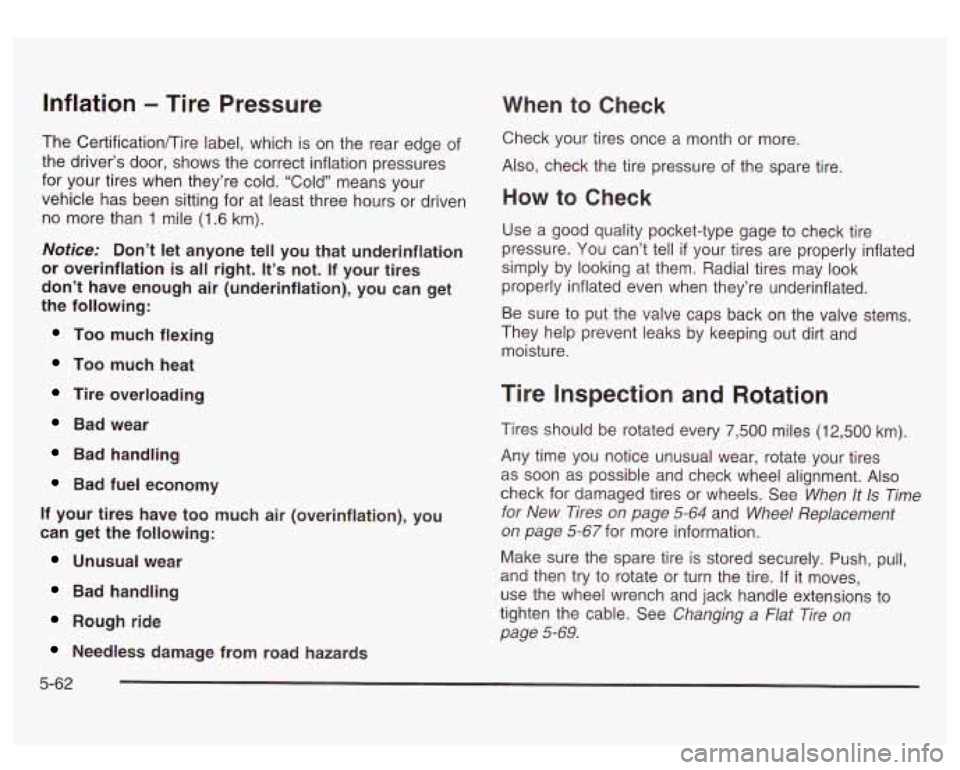
Inflation - Tire Pressure
The CertificationKire label, which is on the rear edge of
the driver’s door, shows the correct inflation pressures
for your tires when they’re cold. “Cold” means your
vehicle has been sitting for at least three hours or driven
no more than
1 mile (1.6 km).
Notice: Don’t let anyone tell you that underinflation
or overinflation is all right. It’s not. If your tires
don’t have enough air (underinflation), you can get
the following:
Too much flexing
Too much heat
Tire overloading
Bad wear
Bad handling
Bad fuel economy
If your tires have too much air (overinflation), you
can get the following:
Unusual wear
Bad handling
Rough ride
Needless damage from road hazards
5-62
When to Check
Check your tires once a month or more.
Also, check the tire pressure of the spare tire
How to Check
Use a good quality pocket-type gage to check tire
pressure. You can’t tell
if your tires are properly inflated
simply by looking at them. Radial tires may look
properly inflated even when they’re underinflated.
Be sure to put the valve caps back on the valve stems.
They help prevent leaks by keeping out dirt and
moisture.
Tire Inspection and Rotation
Tires should be rotated every 7,500 miles (12,500 km).
Any time you notice unusual wear, rotate your tires
as soon as possible and check wheel alignment.
Also
check for damaged tires or wheels. See When It Is Time
for New Tires on page 5-64 and Wheel Replacement
on page
5-67 for more information.
Make sure the spare tire
is stored securely. Push, pull,
and then try to rotate
or turn the tire. If it moves,
use the wheel wrench and jack handle extensions to
tighten the cable. See
Changing a Flat Tire on
page
5-69.
Page 332 of 428
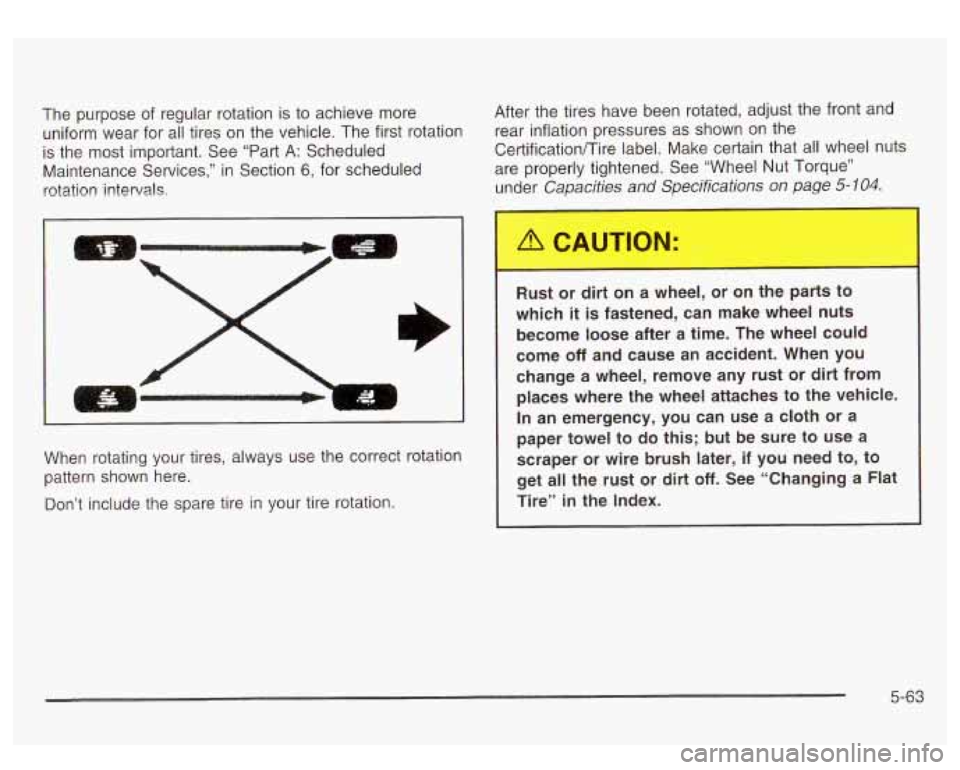
The purpose of regular rotation is to achieve more
uniform wear for all tires on the vehicle. The first rotation
is the most important. See “Part A: Scheduled
Maintenance Services,” in Section
6, for scheduled
rotation
intervals;
After the tires have been rotated, adjust the front and
rear inflation pressures as shown on the
CertificationEire label. Make certain that all wheel nuts
are properly tightened. See “Wheel Nut Torque”
under
Capacities and Specificatiol on ge 5-104.
When rotating your tires, always use the correct rotation
pattern shown here.
Don’t include the spare tire in your tire rotation. Rust or dirt on a
wheel, or on the parts to
which
it is fastened, can make wheel nuts
become loose after a time. The wheel could
come
off and cause an accident. When you
change a wheel, remove any rust or dirt from
places where the wheel attaches to the vehicle,
In an emergency, you can use a cloth or a
paper towel to do
this; but be sure to use a
scraper or wire brush later,
if you need to, to
get all the rust or dirt
off. See “Changing a Flal
Tire”
in the Index.
5-63
Page 354 of 428

PUSH & PULL
6. Make sure the tire is stored securely. Push, pull,
and then try to rotate or turn the tire.
If the tire
moves, use the wheel wrench/hoist shaft to tighten
the cable.
Spare Tire
Your vehicle, when new, had a fully inflated spare tire.
A spare tire may lose air over time, so check its
inflation pressure regularly. See
Inflation -- Tire Pressure
on page 5-62 and Loading Your Vehicle on page 4-45
for information regarding proper tire inflation and loading
your vehicle. For instruction on how to remove, install
or store a spare tire, see
Changing a Flat Tire on
page
5-69.
After installing the spare tire on your vehicle, you should
stop as soon as possible and make sure the spare is
correctly inflated. Have the damaged or flat road
tire repaired or replaced as soon as you can and
installed back onto your vehicle. This way, a spare tire
will be available in case you need it again.
If your vehicle has a spare tire that does not match your
vehicle’s original road tires and wheels in size and
type, do not include the spare in the tire rotation.
Replace the jack, tools and spare tire
lock, if equipped.
5-85
Page 385 of 428
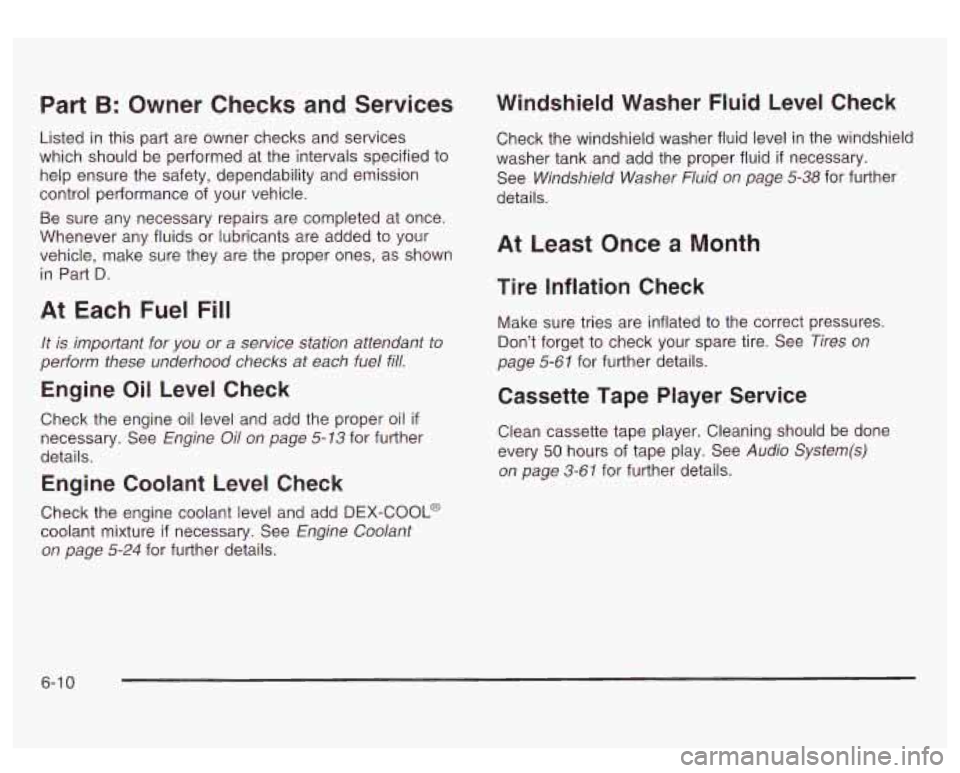
Part B: Owner Checks and Services
Listed in this part are owner checks and services
which should be performed at the intervals specified to
help ensure the safety, dependability and emission
control performance of your vehicle.
Be sure any necessary repairs are completed at once.
Whenever any fluids or lubricants are added to your
vehicle, make sure they are the proper ones, as shown
in Part
D.
At Each Fuel Fill
It is important for you or a service station attendant to
perform these underhood checks at each fuel fill.
Engine Oil Level Check
Check the engine oil level and add the proper oil if
necessary. See Engine Oil on page 5-13 for further
details.
Engine Coolant Level Check Windshield Washer Fluid Level Check
Check
the windshield washer fluid level in the windshield
washer tank and add the proper fluid
if necessary.
See
Windshield Washer Fluid on page 5-38 for further
details.
At Least Once a Month
Tire Inflation Check
Make sure tries are inflated to the correct pressures.
Don’t forget to check your spare tire. See
Tires on
page 5-61
for further details.
Cassette Tape Player Service
Clean cassette tape player. Cleaning should be done
every
50 hours of tape play. See Audio System(s)
on page 3-61
for further details.
Check the engine coolant level and add
DEX-COOL@
coolant mixture if necessary. See Engine Coolant
on page
5-24 for further details.
6-1 0
Page 386 of 428

At Least Twice a Year
Restraint System Check
Make sure the safety belt reminder light and all your
belts, buckles, latch plates, retractors and anchorages
are working properly. Look for any other loose or
damaged safety belt system parts.
If you see anything
that might keep a safety belt system from doing its
job, have it repaired. Have any torn or frayed safety belts
replaced.
Also look for any opened or broken air bag coverings,
and have them repaired or replaced. (The air bag
system does not need regular maintenance.)
Wiper Blade Check
Inspect wiper blades for wear or cracking. Replace
blade inserts that appear worn or damaged or that
streak or miss areas of the windshield.
Also see
Cleaning the Outside of Your Vehicle on page 5-88.
Spare Tire Check
At least twice a year, after the monthly inflation check of
the spare tire determines that the spare is inflated to
the correct tire inflation pressure, make sure that
the spare tire is stored securely. Push, pull, and then try
to rotate or turn the tire. If it moves, use the wheel
wrenchhatchet to tighten the cable. See
Changing a Flat
Tire on page 5-69.
Weatherstrip
Silicone grease on
longer, seal better,
Lubrication
weatherstrips will make them last
and not stick or squeak. Apply
silicone grease with a clean cloth. During very -cold,
damp weather more frequent application may be
required. See
Part D: Recommended Fluids and
lubricants on page
6- 16.
Automatic Transmission Check
Check the transmission fluid level; add if needed. See
Automatic Transmission Fluid on page 5-27. A fluid loss
may indicate a problem. Check the system and repair
if needed.
At Least Once a Year
Key Lock Cylinders Service
Lubricate the key lock cylinders with the lubricant
specified in Part D.
Body Lubrication Service
Lubricate all body door hinges, hood latch assembly,
secondary latch, pivots, spring anchor, release
pawl, tailgate hinge, tailgate linkage, tailgate handle
pivot points, latch bolt, fuel door hinge, locks and folding
seat hardware. Part
D tells you what to use. More
frequent lubrication may be required when exposed to a
corrosive environment.
6-1 1
Page 416 of 428
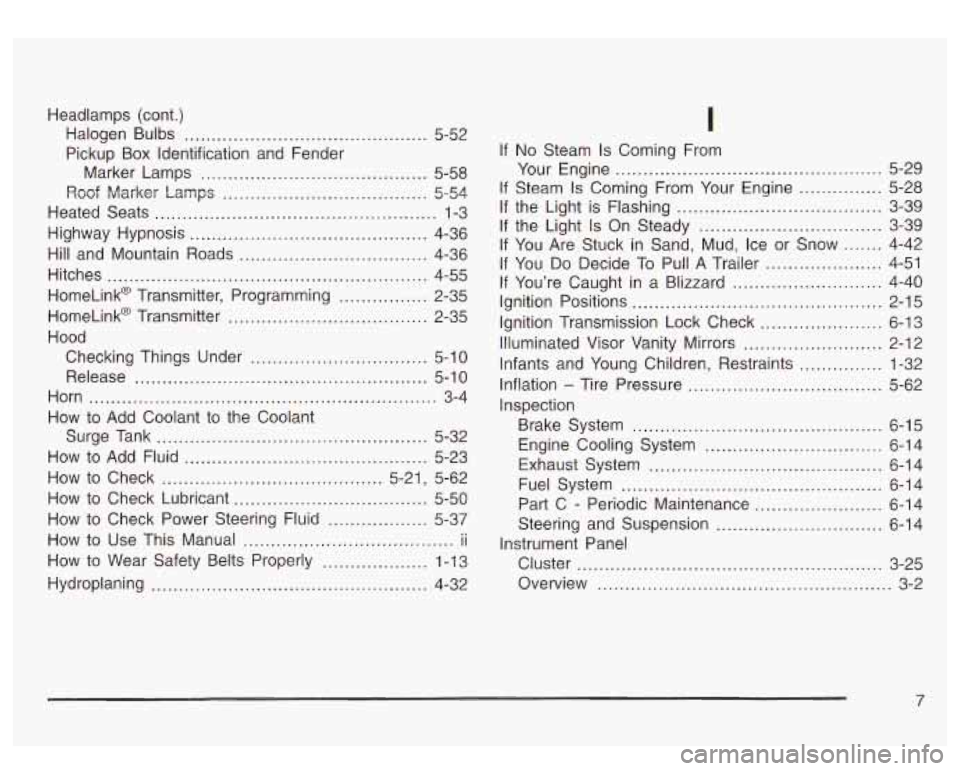
Headlamps (cont.) Halogen Bulbs
............................................ 5-52
Pickup Box Identification and Fender
Marker Lamps
......................................... 5-58
Roof Marker Lamps
..................................... 5-54
Heated Seats
................................................... 1-3
Highway Hypnosis
........................................... 4-36
Hill and Mountain Roads
.................................. 4-36
Hitches
.......................................................... 4-55
HomeLink@ Transmitter
.................................... 2-35
Hood Checking Things Under
................................ 5-10
Release
..................................................... 5-1 0
Horn ............................................................... 3-4
How to Add Coolant
to the Coolant
Surge Tank
................................................. 5-32
How
to Add Fluid ............................................ 5-23
How
to Check ........................................ 5-21, 5-62
How to Check Lubricant
................................... 5-50
How to Use This Manual
.............. ......... ii
How to Wear Safety Belts Properly ................... 1-1 3
HomeLink@ Transmitter, Programming
................ 2-35
How to Check Power Steering Fluid
.................. 5-37
Hydroplaning
.................................................. 4-32
I
if No Steam Is Coming From
Your Engine
................................................ 5-29
If Steam
Is Coming From Your Engine ............... 5-28
If the Light is Flashing ..................................... 3-39
If the Light is On Steady
................................. 3-39
If You Are Stuck in Sand, Mud, Ice or Snow
....... 4-42
If You Do Decide To Pull A Trailer ..................... 4-51
If You’re Caught in a Blizzard ........................... 4-40
Ignition Transmission Lock Check
...................... 6-13
Illuminated Visor Vanity Mirrors
......................... 2-12
infants and Young Children, Restraints
............... 1-32
Inflation
- Tire Pressure ................................... 5-62
inspection Ignition Positions
............................................. 2-15
Brake System
............................................. 6-15
Exhaust System
.......................................... 6-14
Fuel System
............................................... 6-14
Engine Cooling System
................................ 6-14
Part
C - Periodic Maintenance ....................... 6-14
Steering and Suspension
.............................. 6-14
Cluster
....................................................... 3-25
Overview
..................................................... 3-2
Instrument Panel
7
Page 423 of 428
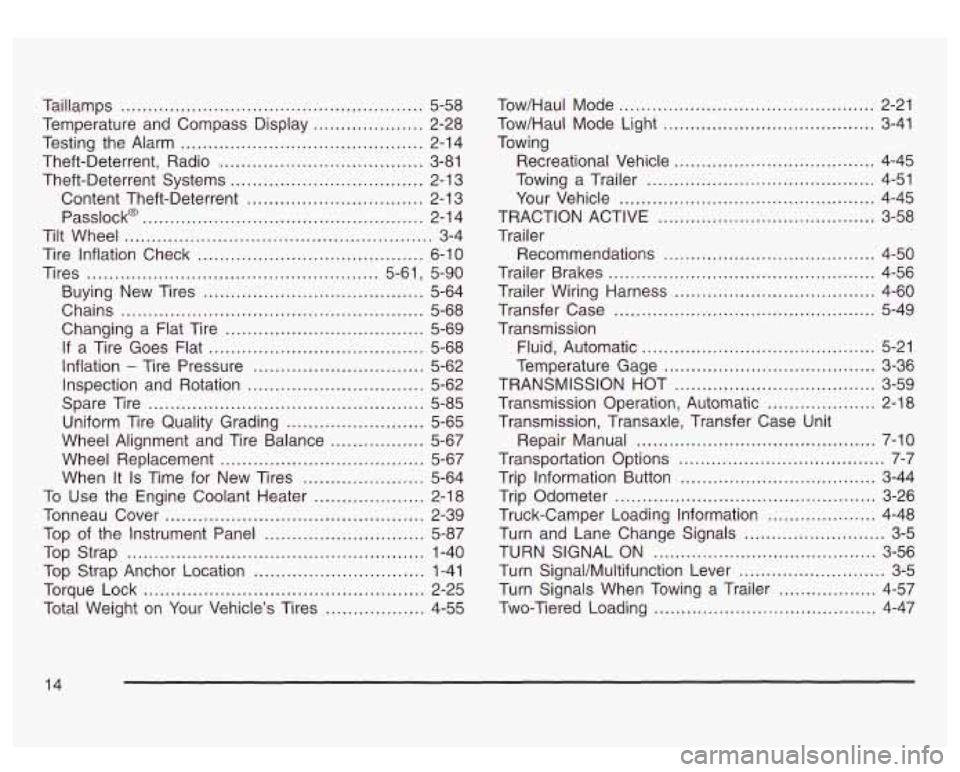
Taillamps ....................................................... 5-58
Temperature and Compass Display
.................... 2-28
Testing the Alarm
............................................ 2-14
Theft.Deterrent. Radio
..................................... 3-81
Theft-Deterrent Systems
................................... 2-1 3
Content Theft-Deterrent
................................ 2-1 3
Passlock@
................................................... 2-1 4
Tilt Wheel
........................................................ 3-4
Tire Inflation Check
......................................... 6-10
Tires
..................................................... 5.61. 5-90
Buying New Tires
........................................ 5-64
Chains
....................................................... 5-68
Changing a Flat Tire
.................................... 5-69
If a Tire Goes Flat ....................................... 5-68
Inflation
- Tire Pressure ............................... 5-62
Inspection and Rotation
................................ 5-62
Spare Tire
.................................................. 5-85
Uniform Tire Quality Grading
......................... 5-65
Wheel Alignment and Tire Balance
................. 5-67
Wheel Replacement
..................................... 5-67
When It
Is Time for New Tires ...................... 5-64
To Use the Engine Coolant Heater .................... 2-18
Tonneau Cover
............................................ 2-39
Top of the Instrument Panel
.......... ........ 5-87
Top Strap
...................................................... 1-40
Top Strap Anchor Location
............................... 1-41
Torque Lock
................................................... 2-25
Total Weight on Your Vehicle’s Tires
.................. 4-55 Tow/Haul
Mode
............................................... 2-21
Tow/Haul Mode Light
....................................... 3-41
Towing Recreational Vehicle
..................................... 4-45
Towing a Trailer
.......................................... 4-51
Your Vehicle
............................................... 4-45
TRACTION ACTIVE
.................................... 3-58
Trailer Recommendations
....................................... 4-50
Trailer Brakes
................................................. 4-56
Trailer Wiring Harness
..................................... 4-60
Transfer Case
................................................ 5-49
Transmission Fluid, Automatic
.......................... ......... 5-21
Temperature Gage
....................................... 3-36
TRANSMISSION HOT
..................................... 3-59
Transmission Operation, Automatic
.................... 2-18
Transmission, Transaxle, Transfer Case Unit Repair Manual
............................................ 7-10
Transportation Options
...................................... 7-7
Trip Information Button
....................... ..... 3-44
Trip Odometer
................................................ 3-26
Truck-Camper Loading Information
.................... 4-48
Turn and Lane Change Signals
.......................... 3-5
Turn SignaVMultifunction Lever ........................... 3-5
Turn Signals When Towing a Trailer
.................. 4-57
Two-Tiered Loading
......................................... 4-47
TURN
SIGNAL ON
......................................... 3-56
14